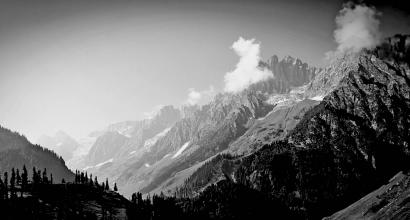The Story of Guṇāḍhya in the Nepāla-māhātmya
The Nepāla-māhātmya comprises four chapters—twenty-seven to thirty—in the Himavat-khaṇḍa of the Skanda-purāṇa. It narrates the greatness of Bhṛṅgīśvara-liṅga. It is said that Guṇāḍhya installed this liṅga. And because he was said to be an avatāra of Bhṛṅgi, it got the name ‘Bhṛṅgīśvara-liṅga.’(Since this is part of a purāṇa, at the great yāga of Janamejaya, upon the request of Jaiminī, Mārkāṇḍeya narrates this episode to all the ṛṣis in the assembly.)
Once upon a time, in Kailāsa, when Pārvatī was all alone with Śiva, she requested him to narrate a strange story that nobody knew. He had the doors shut, installed Nadikeśvara as a sentinel outside, and ordered that nobody should enter. Taking the form of a bhṛṅga (beetle, bee), Bhṛṅgi entered the door through an opening and heard the story entirely, which he subsequently narrated to his wife Vijayā. Later, when Pārvatī was with her friends and associates, she began narrating this story. Vijayā, who was also present, blurted out in the middle of the narration that she already knew this story. Pārvatī complained about this to Śiva. Through dhyāna, Śiva learnt about all that transpired and pronounced a śāpa (curse) on Bhṛṅgi – “Go to earth and become a resident of the South, compose nine hundred thousand gāthas full of rasa (aesthetic joy) and also establish a liṅga in a place that is extremely hard to reach!”
Accordingly, he was born in the town of Mathura as the son of one Viṣṇu-datta. He was named Guṇāḍhya. He went to Ujjayinī, which was ruled by Madana-rāja. The king’s preceptor Śarva-varmā ensured that Guṇāḍhya received royal patronage. The king had a wife named Līlāvatī, who was a Gauḍīya princess renowned for her beauty and scholarship. The king was not well-versed in grammar. Once, while engaged in jala-krīḍa (sporting in water) with his wife, he understood the word ‘modaka’ as ‘laḍḍuka’ and became the butt of ridicule. Guṇāḍhya promised the king that he would teach him grammar in a matter of twelve years. Śarva-varmā, however, said that only two years would suffice.
“If you are able to accomplish it in two years, I’ll give away everything I have to you, renounce Sanskrit, and will retire to the forest”, vowed Guṇāḍhya. Likewise Śarva-varmā too vowed that if he cannot do it in two years he’ll do the same and he worshipped Kumāra-svāmī. He gave him a new form of grammar called Kalāpa (aptly named after the peacock’s tail, the vehicle of Kumāra-svāmī). By studying that Madana became a scholar and to fulfil his vow, Guṇāḍhya gave away all his possessions to Śarva-varmā, renounced Sanskrit and went to the forest.
Guṇāḍhya built a hermitage there and wore matted locks. Once, while he was performing penance, an ascetic by name Pulastya came there. After receiving his hospitality, he was asked by Guṇāḍhya in the ‘Language’ (bhāṣā) thus, “Respected Sir, you know everything about me; can you tell me how I can overcome this situation?”. He said “Compose nine lakh gāthās in Piśāca/Paiśācī language; after doing so, consecrate a Śiva-liṅga in Nepal; you’ll then attain mokṣa.”. Guṇāḍhya wrote the gāthās, one after the other. He wrote them on leaves of trees by employing mineral colours available in the forest. Once, composed, he read them for himself. The animals, upon hearing these gāthās were awestruck - they stopped eating their food and remained static. Hunters easily killed the animals and brought them to the palace. The king having eaten the meat, asked the hunters, “What is the reason for this?” They replied - “All animals are behaving in the same manner; we don’t know the reason”. The king commanded them, “Go and figure out the reason”. They came to the place where they had seen the animals and got mesmerised by the stories narrated by Guṇāḍhya and never returned to the palace. When the king found that his meals were devoid of meat, he asked the cooks about it. They replied, “No meat here, Sir! The hunters went to the forest and never came back. They, perhaps went to the abode of Yama (the God of death)”. The king along with the scholar Śarva-varmā went to the forest and witnessed how Guṇāḍhya was narrating fascinating stories and how the animals were mesmerised upon listening to him. Guṇāḍhya received them with respect. The king asked him to return to the city and take his residence there as he had in the past. Guṇāḍhya replied, “O king! I’ve composed nine lakh gāthās in the Paiśācī language - please get them translated to Sanskrit. I’m going to the holiest of the places, Nepal.”. Having said so, Guṇāḍhya headed towards the Śleṣmāntaka forest. The king brought back all the leaves to the city.
Guṇāḍhya performed the Kṣetra-pradakṣiṇā (circumambulation of the holy site), installed the Śiva-liṅga and went to Kailāsa.
इमं नेपालमाहात्म्यं गुह्यमत्यन्तदुर्लभम् ।
गोपनीयं प्रयत्नेन धार्मिकाय प्रकाशयेत् ॥
(इति स्कन्दपुराणे हिमवत्खण्डे नेपालमाहात्म्ये त्रिंशोऽध्यायः)
This greatness (divinity) of Nepal, mysterious and rare, should be kept in secret and revealed only to people who adhere to dharma.
The Kashmir recension has elaborated this story, and also has removed all its charm. The following is a half verse that occurs in Nepāla-māhātmyaṃ
यस्यान्तं न जानन्ति ब्रह्मा हरिरपि स्वयम्
This has been extrapolated into a full story. Vararuci, Pāṇinī, Vyāḍī and others have also been dragged into the story and is filled with ghosts like Kāṇabhūti; Guṇāḍhya has been made to write the stories of seven Vidyādharās spanning seven lakh verses using his own blood as ink and later made to destroy six of those stories by burning them. Here, the king is not Sātavāhana, but Madana; He is not from Pratiṣṭhāna but is from Ujjayinī. He did not learn Paiśācī and write the stories in Kathā-pīṭha. Guṇāḍhya only renounced Sanskrit but was not forbidden from using Prakrit or other languages (deśya/deśa-bhāṣā). Therefore, the Paiśācī language need not diverge from all the three i.e. Sanskrit, Prakrit and deśa-bhāṣā. Here too, he requests the king to get it translated in Sanskrit. This means that, by the time this work, Nepāla-māhātmyaṃ came into existence, the Sanskrit Bṛhat-kathā might have been available in Nepal. It might as well have been in a versified form. We cannot say if the Paiśācī version was indeed available; the prevalent belief may have been that the original was composed in the Paiśācī language. From a historical perspective, it is not important to know whether Guṇāḍhya was the incarnation of Puṣpa-danta or Bhṛṅgi; however it is quite plausible that the author was Guṇāḍhya and Paiśācī was the language of the work.
Similar to ‘Nepāla-mahātmya’, even in Kashmir, there must have been a sthala-purāṇa (legend of the land) extolling Śiva’s greatness; the story of Guṇāḍhya may have been picked up from here and placed as the kathā-pīṭha lambaka into Kashmir’s Bṛhat-kathā. The kathā-mukha too is an introduction to the story. However, it seems to have been sourced from the original Bṛhat-kathā itself - because it is found in Śloka-saṅgraha also. While Guṇāḍhya’s story is linked inseparably with the main work, it is mentioned therein, that the former was written by Sātavāhana and not Guṇāḍhya. Due to this very fact it can be deduced that it was not a part of the original work, and that it was added later.
In 13th century CE, a poet named Jayadratha composed a work called ‘Hara-carita-cintāmaṇi’, in praise of Śiva’s greatness. It has 32 prakāśas (cantos). The stories of Vararuci, Guṇāḍhya and others appear in the 27th canto. However, it is incidental. The main objectives of the poet were: to describe how, by the grace of Śiva, Pāṇini’s grammar established itself, grew in acclaim and eventually superseded the Aindra grammar; and that Patañjali, the incarnation of Ādi-śeṣa wrote a treatise on it. Also, we see that the stories of Jvālā-liṅga, Vikrama-tuṅga and Jīmūta-vāhana appear in the first, the 24th and the 25th cantos respectively. The author of this work might have perused the work of Somadeva; and along with it, if it was available back then, a Māhātmya (a work of extolation) too. We come to know that such a work existed, through the following śloka of Kṣemendra:
एवं किल पुराणेषु सर्वागम-विधायिषु |
विश्व-शासन-शालिन्यां श्रुतौ च श्रूयते कथाः ||
Indeed in this way, in purāṇas, āgamas, smṛtis and vedas we hear of these stories. However, we cannot determine the extent to which this work contributed to the story he goes on to narrate.
The stories of Guṇāḍhya or Sātavāhana do not appear at the beginning of Bṛhat-kathā-śloka-saṅgraha. It is inconceivable that they would appear within the Jain work of Peruṅgatai. In Bṛhat-kathā-śloka-saṅgraha, Viṣṇu is accorded higher importance than Śiva (IV, 19; VII, please see Gandharvadattā’s Nārāyaṇa-stuti etc). Buddhism, jātaka stories, Jain lore also appear here and there. Throughout the length of the work we see the worship of Vindhya-vāsinī, Caṇḍī and other ārya and non-ārya deities as well as sacrifices. Thus, it is not possible to say for sure as to which caste or faith Guṇāḍhya belonged, or which deities he worshipped. (In the work itself, it is mentioned that he is a brāhmaṇa, but his father is a nāga). Finally, we cannot say with certainty as to where he was born or which province he lived in. As we have already seen, opinion is divided on this.
To be continued...
This is an English translation of Prof. A R Krishna Shastri’s Kannada classic Kathāmṛta by Raghavendra G S, Arjun Bharadwaj, Srishan Thirumalai, and Hari Ravikumar.
The original Kannada version of Kathāmṛta is available for free online reading here. To read other works of Prof. Krishna Shastri, click here.










































